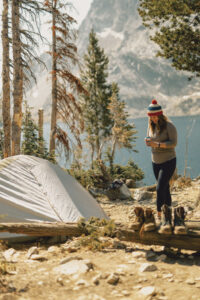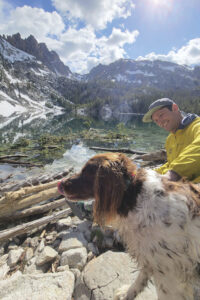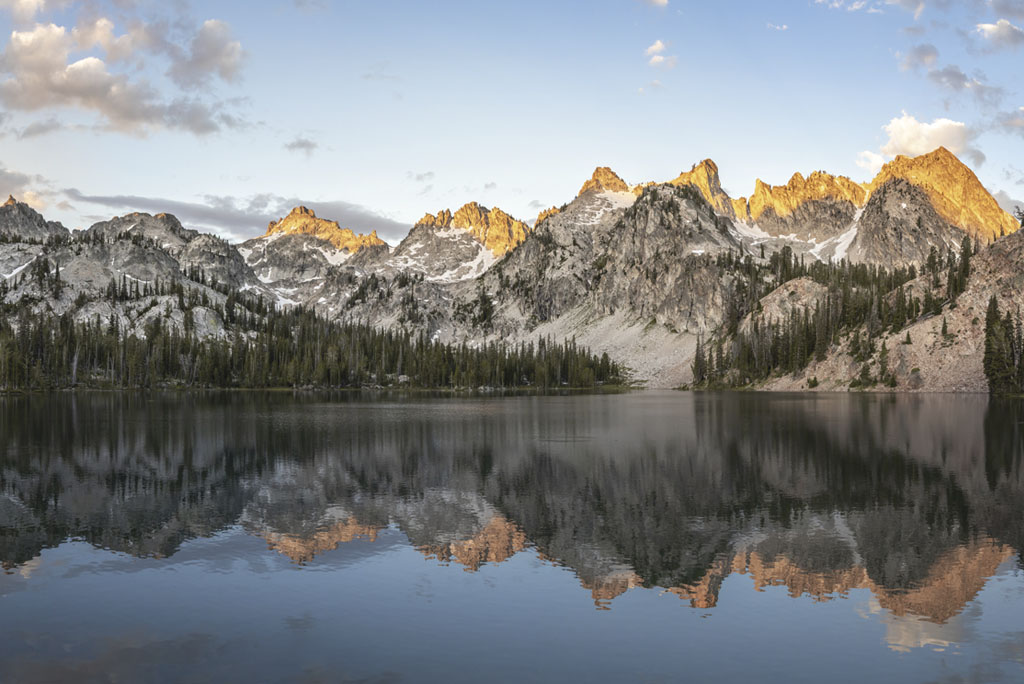Matt Scrivner has been backpacking in Idaho most of his life. He’s been doing it professionally for Sawtooth Mountain Guides since 2012. When asked why people like to walk far distances with heavy things on their backs, he says, “Maybe they’ve been out on a hike and seen someone come down the trail. They’re dirty and smelly; for some reason, there’s an allure to a bigger adventure. They’re intrigued. It’s very human to want to know what’s out there.”
Years of experience have taught Matt the essential roles that proper planning and gear play in a successful venture. Half of his clientele are novice backpackers. He advises that people start small when planning a trip for this demographic. Test the waters and remove as many variables as possible.
“Plan on one night out,” Matt suggests. “Pick an easy-to-follow trail, and don’t expect to be walking more than nine miles a day, especially if there are 2,000 or more feet of elevation gain.”
Selecting the right trail or destination requires consulting the right sources. Sara Gress, the executive director for the Wood River Trails Coalition, a stewardship organization that helps create and maintain the Wood River Valley’s extensive trail network, advises getting information from the people in charge.
“Call the local Ranger District for the Forest Service or Bureau of Land Management office that owns the land,” she recommends, “which means you’ll need to figure out which agencies administer the area you’re going to. This is usually easy to figure out from a map. If you don’t know what those agencies are, start educating yourself on our federal public land management agencies.”
No matter the chosen destination or objective, following Leave No Trace (LNT) practices is always best. LNT aims to protect the environment, wildlife and respect the experiences of fellow travelers by minimizing impact. This principle is achieved through practices such as camping on durable surfaces, digging cat holes for solid waste and avoiding the creation of fire rings. Apart from being eyesores, fires built directly on the ground with no firepan or blanket can pose unnecessary risks.
“It’s a high alpine environment where the soil isn’t broken down,” explains Matt, “so even if a fire is put out on the surface, it can burn down old tree roots or a decaying log and pop up as hot spots a surprisingly far distance away.”
Once trip details have been ironed out, the weather has been checked, and the rules understood, the packing becomes the next focus. The expert advice is to shell out for the good stuff. “Buy gear from companies that specialize in that gear,” says Matt. “Buy backpacks from backpack companies like Osprey and get them fitted by someone who knows what they’re doing.”
Another benefit to spending more upfront is saving weight on your back, a quality especially important to fast packers like Maddie Miller. Maddie grew up in Ketchum and cut her teeth working for Sawtooth Mountain Guides before moving to Colorado. She continues to guide part-time for Pacific Mountain Guides based out of Washington. She succeeded in summiting the highest point in all 50 states in 41 days, 16 hours and 10 minutes, accompanied by mountaineer Melissa Arnot on each climb except Denali.
Maddie describes backcountry camping as “mountain naps” with minimal comforts. “I bring a bivy sack (a minimalist shelter that only qualifies as a tent in theory) and an ultra-light sleeping bag, and I use my 30-liter backpack as a sleeping pad.”
Fastpacking is long-distance trail running, an activity in which bringing an inflatable pillow or a pair of earbuds is considered an excessive luxury. For Maddie, though, the utilitarian nature of fast packing and backpacking trips, in general, makes the endeavors so attractive. “There’s something really awesome about being completely self-sufficient,” she says. “It’s an opportunity to have everything you need and nothing more.”
The simplicity of foot travel is surprisingly calculated. It’s a world where eggs are dehydrated, toothbrushes are sawed in half, zip ties pass for first-aid equipment and duct tape’s value skyrockets. The wrong equipment will cost more than just dollars, and flaky trip planning can spell disaster. The trails themselves require enormous effort to create and maintain. People invest considerable time and energy to escape, venture farther, and carry the minimum.
“I rarely have more than a night or two anymore,” expresses Sara, “but if I have more time, I will go on big loops that get me multiple nights away from the trailhead. I’m looking for silence away from other humans and to see the new country I haven’t been in yet that’s only accessible by foot.”
Backpacking allows nature’s allure to intertwine with human curiosity. It requires a balance of preparation and spontaneity, self-sufficiency, and respect. It is imperative to remember that every step taken can leave a lasting impact in our quest to be in untouched remoteness. By following expert advice and guidance and embracing simplicity, connection with and protection of majestic places can be achieved simultaneously.
Leave No Trace
Principles of Leave No Trace: Respecting the Environment, Wildlife, and Others
Plan and Prepare: Research regional recreational use regulations, plan for emergencies and meal prep for a
successful trip.
Travel and Camp Responsibly: As often as possible, travel on established trails and camp on hard surfaces or already impacted sites.
Dispose of Waste Properly: Pack it in. Pack it out. Bury excrement at least 6 inches deep and 200 feet from any water source. Pack out used toilet paper. Use human waste disposal kits like Wag Bags in high-use areas.
Leave What You Find: Take only pictures, leave only footprints.
Minimize Campfire Impact: Use firepans
or blankets and avoid fires during high-danger seasons.
Respect Wildlife: Don’t harass, approach or feed wildlife. Manage food and trash and put it where animals can’t get it.
Respect Others: Hopefully, this is self-explanatory.
For more information, visit www.LNT.org
Smart Packing Tips
A pack should never weigh more than 30 percent of your body weight, preferably less.
Put heavier stuff at the bottom and close to your back.
Use loose, soft items like jackets and rain flies to fill empty spaces.
Have access to things you’ll want during the day, like the first-aid kit.
Hang as little as possible on the outside of the pack.
How to plan with your furry friend
When planning a backpacking trip with your dog, prioritize their safety and well-being. Start by asking yourself these questions:
KNOW BEFORE YOU GO …
- What are the regulations and restrictions regarding dogs in the area I wish to visit? Some areas, especially in the wilderness, have leash requirements, and some do not allow dogs.
- Is this trip suited to my dog’s abilities? Bringing an old or overweight dog into the backcountry could be inviting unnecessary risks.

Photo courtesy of Matt Scrivner
- Is it too hot to bring my dog? Dehydration and overheating can lead to serious health emergencies. Provide water, rest and shade as often as possible.
- Is my dog trained? A reliable recall is essential training for off-leash travel. It protects the dog, the wildlife, and others on the trail.
- Do I have the right equipment to keep my dog safe and comfortable? Luckily, many items we bring for ourselves can be used to help our furry friends, but it’s always smart to compile some specialty items just for them. Adjust your kit to meet your dog’s needs and follow the advice of your veterinarian.
- Injuries affecting the airway, ability
to breathe or creating excessive bleeding is an emergency requiring veterinary attention.
PACK A DOGGIE BAG
Tweezers: Handy for removing stuck grasses and seeds, insect stingers or ticks. Monitor your dog for behavioral changes or allergic reactions after a sting or bite. Some ticks carry diseases, and signs of exposure, like lethargy and swelling at the bite site, will show up within a week or so after the event.
Benadryl (diphenhydramine): Administer under veterinary guidance if you suspect an allergic reaction.
Dog-friendly bug spray: Do not spray your dog with DEET. Look for natural repellants like citronella.
Syringe, alcohol wipes and antibiotic ointment: For minor wound care.
Gauze pads
Vet tape: Find medical tape that will not stick to fur or hair. Vet tape is great for keeping bandages in place.
Hydrogen peroxide: Inducing vomiting should be done with discretion and only used after immediately ingesting a known non-corrosive substance.
Dog shoes: Protect your dog’s feet after injury. Have a size large enough to accommodate bandaging.
Muzzle: Good to have when your dog is stressed or injured.
Emergency carrier: Consider purchasing a dog sling carrier or evacuation bag.


